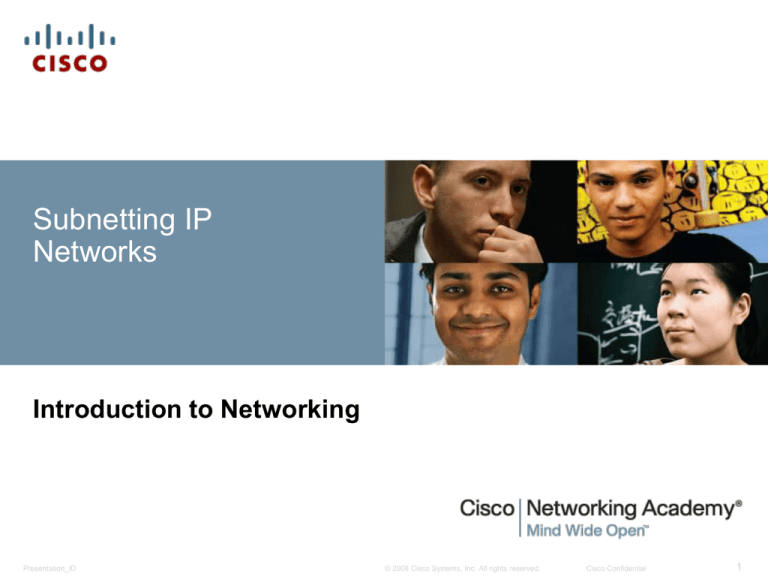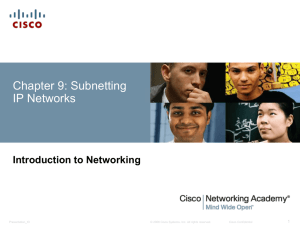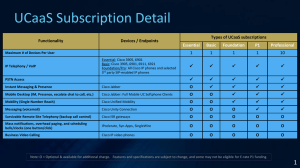
Subnetting IP
Networks
Introduction to Networking
Presentation_ID
© 2008 Cisco Systems, Inc. All rights reserved.
Cisco Confidential
1
Subnetting IP networks
Subnetting an IPv4 Network
Addressing Schemes
Design Considerations for IPv6
Summary
Presentation_ID
© 2008 Cisco Systems, Inc. All rights reserved.
Cisco Confidential
2
Objectives
Explain why routing is necessary for hosts on different
networks to communicate.
Describe IP as a communication protocol used to identify a
single device on a network.
Given a network and a subnet mask, calculate the number of
host addresses available.
Calculate the necessary subnet mask in order to
accommodate the requirements of a network.
Describe the benefits of variable length subnet masking
(VLSM)
Explain how IPv6 address assignments are implemented in a
business network.
Presentation_ID
© 2008 Cisco Systems, Inc. All rights reserved.
Cisco Confidential
3
Network Segmentation
Reasons for Subnetting
Large networks need to be segmented into smaller sub-networks,
creating smaller groups of devices and services in order to:
Control traffic by containing broadcast traffic within subnetwork
Reduce overall network traffic and improve network performance
Subnetting - process of segmenting a network into multiple smaller
network spaces called subnetworks or Subnets.
Communication Between Subnets
A router is necessary for devices on different networks and subnets
to communicate.
Each router interface must have an IPv4 host address that belongs to
the network or subnet that the router interface is connected to.
Devices on a network and subnet use the router interface attached to
their LAN as their default gateway.
Presentation_ID
© 2008 Cisco Systems, Inc. All rights reserved.
Cisco Confidential
4
Subnetting an IPv4 Network
IP Subnetting is FUNdamental
Presentation_ID
© 2008 Cisco Systems, Inc. All rights reserved.
Cisco Confidential
5
Subnetting an IPv4 Network
Basic Subnetting
Borrowing Bits to Create Subnets
Borrowing 1 bit 21 = 2 subnets
Borrowing 1 Bit from the host portion creates 2 subnets with the same subnet mask
Presentation_ID
Subnet 0
Subnet 1
Network 192.168.1.0-127/25
Network 192.168.1.128-255/25
Mask: 255.255.255.128
Mask: 255.255.255.128
© 2008 Cisco Systems, Inc. All rights reserved.
Cisco Confidential
6
Subnetting an IPv4 Network
Subnets in Use
Subnet 0
Network 192.168.1.0-127/25
Subnet 1
Network 192.168.1.128-255/25
Presentation_ID
© 2008 Cisco Systems, Inc. All rights reserved.
Cisco Confidential
7
Subnetting an IPv4 Network
Subnetting Formulas
Calculate Number of Subnets
Calculate Number of Hosts
Presentation_ID
© 2008 Cisco Systems, Inc. All rights reserved.
Cisco Confidential
8
Subnetting an IPv4 Network
Creating 4 Subnets
Borrowing 2 bits to create 4 subnets. 22 = 4 subnets
Presentation_ID
© 2008 Cisco Systems, Inc. All rights reserved.
Cisco Confidential
9
Subnetting an IPv4 Network
Creating 8 Subnets
Borrowing 3 bits to Create 8 Subnets. 23 = 8 subnets
Presentation_ID
© 2008 Cisco Systems, Inc. All rights reserved.
Cisco Confidential
10
Subnetting an IPv4 Network
Creating 8 Subnets(continued)
Presentation_ID
© 2008 Cisco Systems, Inc. All rights reserved.
Cisco Confidential
11
Determining the Subnet Mask
Subnetting Based on Host Requirements
There are two considerations when planning subnets:
Number of Subnets required
Number of Host addresses required
Formula to determine number of useable hosts
2^n-2
2^n (where n is the number the number of host bits remaining) is
used to calculate the number of hosts
-2 Subnetwork ID and broadcast address cannot be used on each
subnet
Presentation_ID
© 2008 Cisco Systems, Inc. All rights reserved.
Cisco Confidential
12
Determining the Subnet Mask
Subnetting Network-Based Requirements
Calculate number of subnets
Formula 2^n (where n is the number of bits borrowed)
Subnet needed for
each department in
graphic
Presentation_ID
© 2008 Cisco Systems, Inc. All rights reserved.
Cisco Confidential
13
Determining the Subnet Mask
Subnetting To Meet Network Requirements
It is important to balance the number of subnets needed
and the number of hosts required for the largest subnet.
Design the addressing scheme to accommodate the
maximum number of hosts for each subnet.
Allow for growth in
each subnet.
Presentation_ID
© 2008 Cisco Systems, Inc. All rights reserved.
Cisco Confidential
14
Determining the Subnet Mask
Subnetting To Meet Network Requirements (cont)
Presentation_ID
© 2008 Cisco Systems, Inc. All rights reserved.
Cisco Confidential
15
Benefits of Variable Length Subnet Masking
Traditional Subnetting Wastes Addresses
Traditional subnetting - same number of addresses is
allocated for each subnet.
Subnets that require fewer addresses have unused
(wasted) addresses. For example, WAN links only need 2
addresses.
Variable Length Subnet Mask (VLSM) or subnetting a
subnet provides more efficient use of addresses.
Presentation_ID
© 2008 Cisco Systems, Inc. All rights reserved.
Cisco Confidential
16
Benefits of Variable Length Subnet Masking
Variable Length Subnet Masks (VLSM)
VLSM allows a network space to be divided in unequal
parts.
Subnet mask will vary depending on how many bits have
been borrowed for a particular subnet.
Network is first subnetted, and then the subnets are
subnetted again.
Process repeated as necessary to create subnets of
various sizes.
Presentation_ID
© 2008 Cisco Systems, Inc. All rights reserved.
Cisco Confidential
17
Benefits of Variable Length Subnet Masking
Basic VLSM
Presentation_ID
© 2008 Cisco Systems, Inc. All rights reserved.
Cisco Confidential
18
Benefits of Variable Length Subnet Masking
VLSM in Practice
Using VLSM subnets, the LAN and WAN segments in
example below can be addressed with minimum waste.
Each LANs will be assigned a subnet with /27 mask.
Each WAN link will be assigned a subnet with /30 mask.
Presentation_ID
© 2008 Cisco Systems, Inc. All rights reserved.
Cisco Confidential
19
Benefits of Variable Length Subnet Masking
VLSM Chart
Presentation_ID
© 2008 Cisco Systems, Inc. All rights reserved.
Cisco Confidential
20
Structured Design
Planning to Address the Network
Allocation of network addresses should be planned and
documented for the purposes of:
Preventing duplication of addresses
Providing and controlling access
Monitoring security and performance
Addresses for Clients - usually dynamically assigned using
Dynamic Host Configuration Protocol (DHCP)
Sample Network
Addressing Plan
Presentation_ID
© 2008 Cisco Systems, Inc. All rights reserved.
Cisco Confidential
21
Subnetting an IPv6 Network
Subnetting Using the Subnet ID
An IPv6 Network Space is subnetted to support
hierarchical, logical design of the network
Presentation_ID
© 2008 Cisco Systems, Inc. All rights reserved.
Cisco Confidential
22
Subnetting an IPv6 Network
IPV6 Subnet Allocation
Presentation_ID
© 2008 Cisco Systems, Inc. All rights reserved.
Cisco Confidential
23
Subnetting an IPv6 Network
Subnetting into the Interface ID
IPv6 bits can be borrowed from the interface ID to create
additional IPv6 subnets
Presentation_ID
© 2008 Cisco Systems, Inc. All rights reserved.
Cisco Confidential
24
Summary
Process of segmenting a network, by dividing it into to
multiple smaller network spaces, is called subnetting.
Subnetting a subnet, or using Variable Length Subnet
Mask (VLSM) was designed to avoid wasting addresses.
IPv6 address space is a huge address space so it is
subnetted to support the hierarchical, logical design of
the network not to conserve addresses.
Size, location, use, and access requirements are all
considerations in the address planning process.
IP networks need to be tested to verify connectivity and
operational performance.
Presentation_ID
© 2008 Cisco Systems, Inc. All rights reserved.
Cisco Confidential
25
Presentation_ID
© 2008 Cisco Systems, Inc. All rights reserved.
Cisco Confidential
26







